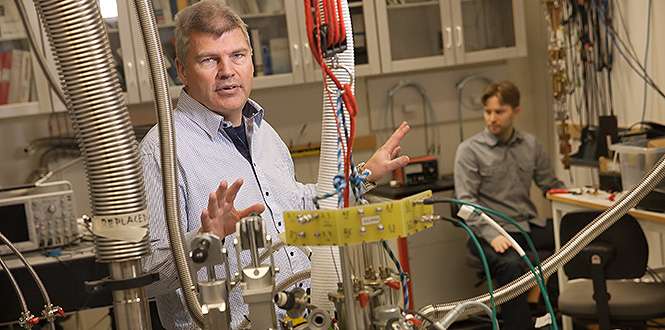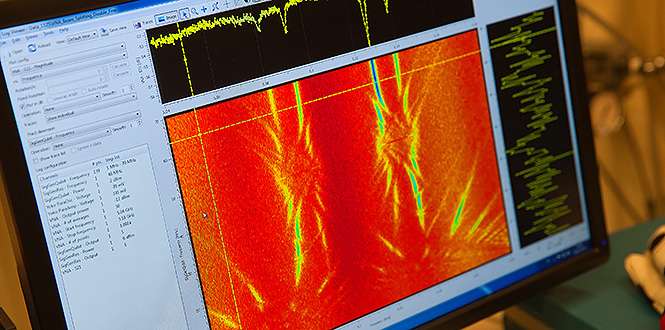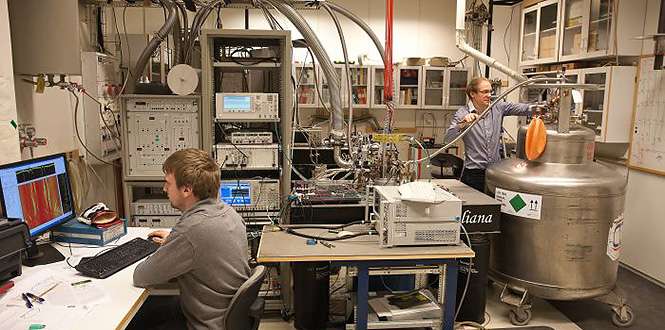Twin paradox on a chip

Per Delsing and his team want to combine theoretical calculations with experiments on superconducting circuits to gain an understanding of how things fit together at the nano level. Among other things, they plan to simulate objects that move very rapidly, almost at the speed of light, and demonstrate the "twin paradox" on a microchip.
Stuck on the wall of Per's office is a piece of paper on which is written: "It is easier to control a photon than it is to bring up four daughters."
"That's right," says Per, who is Professor of Experimental Physics at Chalmers University of Technology, without a second's hesitation.
But then again, he is a wiz at controlling photons – small particles of light. Among other things, his research team has succeeded in generating photons directly out of a vacuum. In their project, which has received funding from the Knut and Alice Wallenberg Foundation, they are using photons to demonstrate the twin paradox in a new way. The paradox is a thought experiment stemming from Einstein's special theory of relativity, and has occupied the minds of physicists for more than a hundred years.
Per, who happens to be a twin himself, explains:
"The twin paradox says that if I take a space journey in a high-speed rocket and then return, as an effect of acceleration I will be much younger than my twin brother. This effect has been measured in various ways. What we want to do now is to demonstrate this on a microchip."
In other words, instead of traveling into space, his research team will move photons a very short distance at nano level.
"But the photons travel so quickly, close to the speed of light, which is difficult for us to reach in reality. And this is why we can achieve an effect even though this space journey only takes place on the actual chip."
The trick – a superconducting circuit

The team is using a special type of superconducting electric circuit called SQUID, which stands for Superconducting Quantum Interference Device, which has been made in Chalmers' advanced clean room. When Per's team showed in 2011 how to create photons out of a vacuum, they used the specially designed SQUIDs as ultra-high-speed mirrors to generate light particles.
In addition to the twin paradox, the project aims to study two other new physical phenomena on microchips: "photon condensation" and "frequency combs".
"We always work on the boundaries of what is possible and what is new. The grant will enable us to realize these ideas and see how far we can go. The Foundation has also given us great freedom to use the resources as we ourselves see fit."
It works in theory
A research team led by Göran Johansson (one of the co-investigators), Professor of Theoretical Physics at Chalmers, has published a scientific article showing that it is theoretically possible to demonstrate the twin paradox on a microchip. Per emphasizes how important it is to give a theoretical description of what is being done in practice.
"Sometimes it is easier to test in theory first; sometimes it is better to start by experimenting. So when we have recorded our data, the theoreticians make a model based on the results, and, hopefully, are able to reproduce our data so that they match. That is what we want to achieve. This is teamwork, and we know each other well. The theoreticians know what equipment we have, and we know what theoretical models and methods they have."
The third research team in the project is being led by David Haviland, Professor of Nanostructure Physics at KTH Royal Institute of Technology. He is developing methods of generating and analyzing signals with many tones at low frequencies (10 – 100 MHz) in "frequency combs".
"The good thing is that we can combine our equipment with David's and create frequency combs in the microwave region," Per says.

These frequency combs could in turn be used to drive the resonators used by the researchers to create photons. A resonator is a component that oscillates at a given frequency; in this case, it is a transmission line with a SQUID at each end.
"There are some theories that it might be possible to use frequency combs for quantum information."
Cold and silent with a cryostat
The Foundation's grant will primarily be used to recruit more researchers, and to buy a new cryostat. This apparatus costs about SEK 3 million and is used to cool the SQUID down close to absolute zero. This is necessary for two reasons, as Per explains during a guided tour of the lab.
"First of all, we need to eliminate all the noise generated at higher temperatures. And a cryostat also ensures that our circuits will be superconducting."
Per, who is also a Wallenberg Scholar, is often asked what his research can be used for. The answer is he does not know. He is conducting pure basic research, understanding how everything fits together.
"When we focus on really small things, we are dealing with quantum physics; when we look at the really big picture, we have the general theory of relativity, which describes gravity. These two theories contradict each other to some extent, and have not yet been reconciled. Our research is approaching the limits where we can test things described by these two theories, and there is an opportunity to learn exciting new things."
Provided by Chalmers University of Technology




















